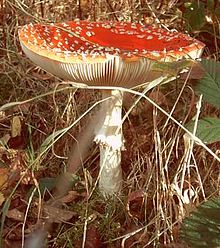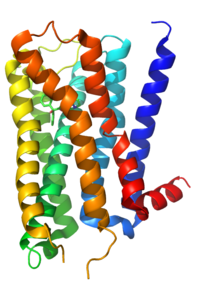Muscarinic acetylcholine receptor




Muscarinic acetylcholine receptors, or mAChRs, are acetylcholine receptors that form G protein-receptor complexes in the cell membranes of certain neurons[1] and other cells. They play several roles, including acting as the main end-receptor stimulated by acetylcholine released from postganglionic fibers in the parasympathetic nervous system.
Muscarinic receptors were named as such because they are more sensitive to muscarine than to nicotine.[2] Their counterparts are nicotinic acetylcholine receptors (nAChRs), receptor ion channels that are also important in the autonomic nervous system. Many drugs and other substances (for example pilocarpine and scopolamine) manipulate these two distinct receptors by acting as selective agonists or antagonists.[3]
Function
Acetylcholine (ACh) is a neurotransmitter found extensively in the brain and the autonomic ganglia. Muscarinic receptors are used in the following roles:
Recovery receptors

ACh is always used as the transmitter within the autonomic ganglion. Nicotinic receptors on the postganglionic neuron are responsible for the initial fast depolarization (Fast EPSP) of that neuron. As a consequence of this, nicotinic receptors are often cited as the receptor on the postganglionic neurons at the ganglion. However, the subsequent hyperpolarization (IPSP) and slow depolarization (Slow EPSP) that represent the recovery of the postganglionic neuron from stimulation are actually mediated by muscarinic receptors, types M2 and M1 respectively (discussed below).
Peripheral autonomic fibers (sympathetic and parasympathetic fibers) are categorized anatomically as either preganglionic or postganglionic fibers, then further generalized as either adrenergic fibers, with their corresponding adrenergic receptors, or cholinergic fibers, with their cholinergic receptors. Both preganglionic sympathetic fibers and preganglionic parasympathetic fibers are cholinergic. All postganglionic sympathetic fibers are adrenergic; their neurotransmitter is norepinephrine, except for the postganglionic sympathetic fibers to the sweat glands, piloerectile muscles of the body hairs, and the skeletal muscle arterioles.
The adrenal medulla is considered a sympathetic ganglion and, like other sympathetic ganglia, is supplied by cholinergic preganglionic sympathetic fibers; acetylcholine is its neurotransmitter. The other postganglionic fibers of the peripheral autonomic system belong to the parasympathetic division; all are cholinergic fibers, and use acetylcholine (ACh) as their neurotransmitter.
Postganglionic neurons
Another role for these receptors is at the junction of the innervated tissue and the postganglionic neuron in the parasympathetic division of the autonomic nervous system. Here acetylcholine is again used as a neurotransmitter, and muscarinic receptors form the principal receptors on the innervated tissue.
Innervated tissue
Very few parts of the sympathetic system use cholinergic receptors. In sweat glands the receptors are of the muscarinic type. The sympathetic nervous system also has some preganglionic nerves terminating at the chromaffin cells in the adrenal medulla, which secrete epinephrine and norepinephrine into the bloodstream. Some believe that chromaffin cells are modified postganglionic CNS fibers. In the adrenal medulla, acetylcholine is used as a neurotransmitter, and the receptor is of the nicotinic type.
The somatic nervous system uses a nicotinic receptor to acetylcholine at the neuromuscular junction.
Higher central nervous system
Muscarinic acetylcholine are also present and distributed throughout the central nervous system, in post-synaptic and pre-synaptic positions. There is also some evidence for postsynaptic receptors on sympathetic neurons allowing the parasympathetic nervous system to inhibit sympathetic effects.
Presynaptic membrane of the neuromuscular junction
It's now known they also appear on the pre-synaptic membrane of somatic neurons in the neuro-muscular junction, where they are involved in the regulation of acetylcholine release.
Form of muscarinic receptors
Muscarinic acetylcholine receptors belong to a class of metabotropic receptors that use G proteins as their signalling mechanism. In such receptors, the signaling molecule (the ligand) binds to a receptor that has seven transmembrane regions; in this case, the ligand is ACh. This receptor is bound to intracellular proteins, known as G proteins, which begin the information cascade within the cell.
By contrast, nicotinic receptors use a ligand-gated ion channel mechanism for signaling. In this case, binding of the ligands with the receptor causes an ion channel to open, permitting either one or more specific type(s) of ion (e.g., K+, Na+, Ca2+) to diffuse into or out of the cell.
Pharmacological application
Ligands targeting the mAChR that are currently approved for clinical use include non-selective antagonists for the treatment of Parkinson's disease,[4] atropine (to dilate the pupil), Scopolamine (used to prevent motion sickness), and ipratropium (used in the treatment of COPD).[3]
See also
References
- ^ Eglen RM (July 2006). "Muscarinic receptor subtypes in neuronal and non-neuronal cholinergic function". Auton Autacoid Pharmacol. 26 (3): 219–33. doi:10.1111/j.1474-8673.2006.00368.x. PMID 16879488.
- ^ Ishii M, Kurachi Y (2006). "Muscarinic acetylcholine receptors". Curr. Pharm. Des. 12 (28): 3573–81. doi:10.2174/138161206778522056. PMID 17073660.
- ^ a b Purves, Dale, George J. Augustine, David Fitzpatrick, William C. Hall, Anthony-Samuel LaMantia, James O. McNamara, and Leonard E. White (2008). Neuroscience. 4th ed. Sinauer Associates. pp. 122–6. ISBN 978-0-87893-697-7.
{{cite book}}: CS1 maint: multiple names: authors list (link) - ^ Langmead CJ, Watson J, Reavill C (February 2008). "Muscarinic acetylcholine receptors as CNS drug targets". Pharmacol. Ther. 117 (2): 232–43. doi:10.1016/j.pharmthera.2007.09.009. PMID 18082893.
{{cite journal}}: CS1 maint: multiple names: authors list (link)
External links
- "Acetylcholine Receptors (Muscarinic)". IUPHAR Database of Receptors and Ion Channels. International Union of Basic and Clinical Pharmacology.
{{cite web}}: Cite has empty unknown parameter:|coauthors=(help) - Receptors,+Muscarinic at the U.S. National Library of Medicine Medical Subject Headings (MeSH)
